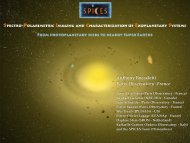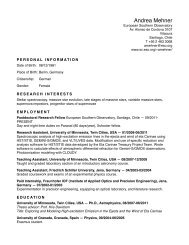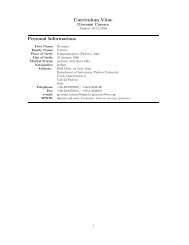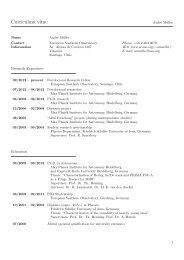Michael F. Sterzik (ESO, Santiago de Chile) Kerstin Geissler (MPIA ...
Michael F. Sterzik (ESO, Santiago de Chile) Kerstin Geissler (MPIA ...
Michael F. Sterzik (ESO, Santiago de Chile) Kerstin Geissler (MPIA ...
- No tags were found...
Create successful ePaper yourself
Turn your PDF publications into a flip-book with our unique Google optimized e-Paper software.
VISIR - VLT Imager and Spectrometer for mid-IR- diffraction limited (0.3” resolution)- high sensitivity N-band imaging (5mJy 10σ /hr)- 11 narrow N band filters- long slit R=350/3000/25000 spectroscopy- queue (service) and visitor mo<strong>de</strong>- reduction pipelineWednesday, August 12, 2009
The case of ε Ind B<strong>Sterzik</strong> et al., 2004Wednesday, August 12, 2009
! Indi Bab and AMES-cond. mo<strong>de</strong>ls10F # [mJy]1T = 800K, 900KT = 1200K, 1300K8 9 10 11 12 13" [µm]Wednesday, August 12, 2009
! Indi B and Burrows, Sudarsky, Hubeny (2006) mo<strong>de</strong>ls10F # [mJy]1T = 800K, 900KT = 1200K, 1300K8 9 10 11 12 13" [µm]Wednesday, August 12, 2009
! Indi B and Hubeny Burrows, & Burrows Sudarsky, (2007) Hubeny mo<strong>de</strong>ls (2006) mo<strong>de</strong>ls10F # " [mJy]T = 800K, 900KT = 1200K, 1300K18 9 10 11 12 13"! [µm]indication for non-equilibrium atmosphereWednesday, August 12, 2009
Star - Brown Dwarf binaries (8.6μ)GJ 229dist ~ 6pcsep. 7”.7SpTy T7T~1000Kage 30-200 MyrsHR 7329dist ~ 50pcsep. 4”.2SpTy M7-M8T~2600Kage 12 MyrsHD 130948dist ~ 18pcsep. 2”.6 + 0”.13SpTy L4+L4T~1900Kage 300-800 Myrs<strong>Geissler</strong>, Chauvin & <strong>Sterzik</strong>, 2008Wednesday, August 12, 2009
Star - Brown Dwarf binaries (8.6μ)GJ 229dist ~ 6pcsep. 7”.7SpTy T7T~1000Kage 30-200 MyrsHR 7329dist ~ 50pcsep. 4”.2SpTy M7-M8T~2600Kage 12 MyrsλmJyλmJy8.6μ 10.5μ 11.3μ3.2(0.5)
Star - Brown Dwarf binaries (8.6μ)GJ 229dist ~ 6pcsep. 7”.7SpTy T7T~1000Kage 30-200 MyrsHR 7329dist ~ 50pcsep. 4”.2SpTy M7-M8T~2600Kage 12 MyrsλmJyλmJy8.6μ 10.5μ 11.3μ3.2(0.5)
Comparison w/ atm. mo<strong>de</strong>ls (GJ229)GJ229BAMES - condT=900Kt=200MyrL&T cloud freeT=900Kt=200MyrPAH1 (3.2+-0.5 mJy)Siv (
Comparison w/ atm. mo<strong>de</strong>ls (GJ229)GJ229BAMES - condT=900Kt=200MyrL&T cloud freeT=900Kt=200MyrPAH1 (3.2+-0.5 mJy)Siv (
Is HD 130948 variable @ 10.5μ?5/Aug/06 3/Aug/06 simulated5.7 ± 0.4 mJy
Is HD 130948 variable @ 10.5μ?5/Aug/06 3/Aug/06 simulated5.7 ± 0.4 mJy
Variability in B.D.sThe Quest for Weather: Silicates, Methane, Ammonia, COL/T transition: cloudy/clear...The Astrophysical Journal, 653:1454Y1463, 2006 December 20Copyright is not claimed for this article. Printed in U.S.A.Wednesday, August 12, 2009A SENSITIVE SEARCH FOR VARIABILITY IN LATE L DWARFS: THE QUEST FOR WEATHERM. Morales-Cal<strong>de</strong>rón, 1, 2 J. R. Stauffer, 3 J. Davy Kirkpatrick, 4 S. Carey, 3 C. R. Gelino, 3D. Barrado y Navascués, 1 L. Rebull, 3 P. Lowrance, 3 M. S. Marley, 5D. Charbonneau, 6,7 B. M. Patten, 6 S. T. Megeath, 6 and D. Buzasi 8Received 2006 June 2; accepted 2006 July 21ABSTRACTWe have conducted a photometric monitoring program of three field late L brown dwarfs (DENIS-P J0255 4700,A&A 2MASS 487, J0908+5032, 277–292 (2008) and 2MASS J2244+2043) looking for evi<strong>de</strong>nce of nonaxisymmetric structureAstronomyor temporalDOI: variability 10.1051/0004-6361:20065075in their photospheres. The observations were performed using Spitzer IRAC 4.5 and 8 m bandpasses and&c○ were <strong>ESO</strong> 2008 <strong>de</strong>signed to cover at least one rotational period of each object; 1 rms uncertainties of less than 3 mmag at 4.5 mand around 9 mmag at 8 m were achieved. Two out of the three objects studied exhibit some modulation in their lightcurves at 4.5 m—but not 8 m—with periods of 7.4 hr (DENIS 0255) and 4.6 hr (2MA 2244) and peak-to-peakamplitu<strong>de</strong>s of 10 and 8 mmag. Although the lack of <strong>de</strong>tectable 8 m variation suggests an instrumental originfor the <strong>de</strong>tected variations, the data may nevertheless still be consistent with intrinsic variability, since the shorterwavelength IRAC bandpasses probe more <strong>de</strong>eply into late L dwarf atmospheres than the longer wavelengths. A cloudfeatureCLOUDS occupying a smallsearchpercentage (1%Y2%)for variabilityof the visible hemispherein browncould accountdwarffor the observedatmospheresamplitu<strong>de</strong>of variation. If, instead, the variability is in<strong>de</strong>ed instrumental in origin, then our nonvariable L dwarfs could be eithercompletely Infrared covered withspectroscopic clouds or objects whosetime cloudsseries are smallerof andL/T uniformly transition distributed. Such brown scenarios dwarfs would ⋆lead to very small photometric variations. Follow-up IRAC photometry at 3.6 and 5.8 m bandpasses should distinguishB. Goldman between 1,2 , the M. two C. cases. Cushing In 3,⋆⋆ any event, , M. S. the Marley present 4 , observations É. Artigau 5 provi<strong>de</strong> , K. S. Baliyan the most 6 , sensitive V. J. S. search Béjar 7 to , J. date A. for Caballero 2,8 ,structureN. Chanoverin the photospheres 1 , M. Connelleyof late 9 L, R.dwarfsDoyonat mid-IR 10 , T. Forveillewavelengths, 11,12 and, S.ourGaneshphotometry 6 , C. R.provi<strong>de</strong>sGelino 1,13 stringent, H. B.upperHammel 14 ,limits to the extent to which the photospheres of these transition L dwarfs are structured.J. Holtzman 1 , S. Joshi 15 , U. C. Joshi 6 , S. K. Leggett 16 , M. C. Liu 9 , E. L. Martín 8 , V. Mohan 17 , D. Na<strong>de</strong>au 10 ,Subject headinggs: stars: individual (DENIS-P J0255 4700, 2MASS J0908+5032, 2MASS J2244+2043) —R. Sagarstars: low-mass, brown dwarfs — stars: 15 , and D. Stephensvariables: other18Astrophysics1 Department of Astronomy, New Mexico State University, Las Cruces, NM 88003, USA2 M.P.I.A., Königstuhl 17, 69117 Hei<strong>de</strong>lberg, Germanye-mail: goldman@mpia.<strong>de</strong>3 Steward 1. Observatory, INTRODUCTION University of Arizona, Tucson, AZ 85721, into discrete USA (patchy) clouds, and eventually those clouds either4 NASA Ames Research Center, Moffett Field, CA 94035, USA shrink or sink below the visible photosphere (Burgasser et al.The onslaught 5 Gemini of L and Observatory, T dwarf Southern discoveries Operations within in Center, the last A.U.R.A., 2002); Inc., Casilla and (3) 603, a ‘‘sud<strong>de</strong>n La Serena, downpour’’ <strong>Chile</strong> (rapid sedimentation period)10 years has enabled 6 Astronomy direct & comparisons Astrophysics Division, betweenPhysical observations Research Laboratory, Navarangpura, Ahmedabad 380 009, Indiaand mo<strong>de</strong>ling 7 occurs, rapidly removing grains from the visible photosphereof GTC brown project. dwarf Instituto cooling <strong>de</strong> Astrofísica tracks. The<strong>de</strong> transition Canarias, regionfrom the 8 late Instituto L dwarfs <strong>de</strong> Astrofísica to the early<strong>de</strong> (Knapp et al. 2004).38205 La Laguna, Tenerife, SpainTCanarias, dwarfs has 38205 always La Laguna, been Tenerife, SpainPhotometric variability is one observable that may be able toproblematic for 9 Institute brown dwarf for Astronomy, atmosphere University mo<strong>de</strong>lers. of Hawaii, First among 2680 Woodlawn Drive, Honolulu, HI 96822, USAprovi<strong>de</strong> constraints which of these mechanisms, if any, is thethe unanswered 10 Observatoire questions relates du Mont to Mégantic the fact that et Département early T dwarfs <strong>de</strong> Physique, Université <strong>de</strong> Montréal, H3C 3J7, C.P. 6128, Montréal, Canadadominant process occurring in very cool atmospheres. The atmospheresof these objects are too cool and neutral to support startend to have 11 absolute Canada-France-Hawaii J magnitu<strong>de</strong>s brighter Telescope than Corporation, later L dwarfs, 65-1238 Mamalahoa Highway, Kamuela, HI 96743, Hawaii, USAthe so-called 12 Observatoire <strong>de</strong> Grenoble, 414 rue <strong>de</strong> la Piscine, Domaine Universitaire <strong>de</strong> St. Martin d’Hères, 38041 Grenoble, FranceJ-band bump (Vrba et al. 2004). Further problemsarise from the 13 Spitzer Science Center, MC 220-6, California Institute of Technology,large dispersion of certain colors as a function ofspots (Mohanty Pasa<strong>de</strong>na, & CA Basri 91125, 2003; USA Gelino et al. 2002), so if variabilityCOexists, 80301, it is USA most likely caused by nonuniform structures in14 Space Science Institute, 4750 Walnut Street, Suite 205, Boul<strong>de</strong>r,spectral type 15 (Knapp Aryabhatta et al. Research 2004) Institute as well of asObservational the discrepancies Sciences (ARIES), the cloud Manora <strong>de</strong>ck. Peak, If the Nainital-263129, objects are not Uttaranchal, variable, India then either thebetween the 16 optical Joint and Astronomy near-IRCentre, <strong>de</strong>rived 660spectral North A’ohoku types ofPlace, someHilo, HItransition objects (Kirkpatrick 2005). Although some of thesevariability 96720, USA17is below the limits of <strong>de</strong>tection, or the cloud <strong>de</strong>cks are
Variability in B.D.s @ 10.5μL/T transition: cloudy/clear...non-equilibrium chemistry / vertical mixingheterogenity of cloud patterns: Silicates, Ammonia, COSaumon, Marley & Lod<strong>de</strong>rs, 2003Hubeny & Burrows, 2007, ApJ669Wednesday, August 12, 2009
Systematic Monitoring of HD 130948SIV PAH1Wednesday, August 12, 2009
Systematic Monitoring of HD 130948SIV PAH1642010-07-06 03-08-06 05-08-06 25-03-08T05 25-03-08T06 25-03-08T07 26-03-08T05 26-03-08T07 26-03-08T08 26-03-08T09 27-03-08T05 27-03-08T07 27-03-08T08 27-03-08T09Wednesday, August 12, 2009
Variability Analysis- Χ 2 analysis (Morales-Cal<strong>de</strong>ron et al.)- η (Enoch et al. 2003, statistically more robust)Χ 2 P ηHD 130948PAH11.8 0.99 0.4HD 130948SIV5.5 0.59 0.7<strong>Geissler</strong> et al., Cool StarsWednesday, August 12, 2009
Variability Analysis- Χ 2 analysis (Morales-Cal<strong>de</strong>ron et al.)- η (Enoch et al. 2003, statistically more robust)Χ 2 P ηHD 130948PAH1HD 130948SIV1.8 0.99 0.4HD 130948 likely not variable in PAH1 and SIV!5.5 0.59 0.7<strong>Geissler</strong> et al., Cool StarsWednesday, August 12, 2009
Systematic Monitoring of ε Ind B2/Oct/04 25/Aug/05 9/Sep/05fol<strong>de</strong>dconvol.waveletincl time series data from 2007Photometric errors systematically measured through simulated sourcesWednesday, August 12, 2009Photometric errors systematically measured through simulated sources
Systematic Monitoring of ε Ind B1412!Ind Ba (PAH2)!Ind Ba (SIV)!Ind Bb(PAH2)!Ind Bb(SIV)10Flux [mJy]8642013-Nov-2007 14-Nov-2007 15-Nov-2007 16-Nov-2007Wednesday, August 12, 2009
Variability AnalysisΧ 2 P ηε Ind BaPAH2ε Ind BaSIVε Ind BbPAH2ε Ind BbSIV40 10 -7 3.120 10 -3 2.115 10 -2 1.89 10 -1 1.4Wednesday, August 12, 2009
Variability AnalysisΧ 2 P ηε Ind BaPAH240 10 -7 3.1ε Ind BaSIVε Ind BbPAH2ε Ind BbSIV20 10 -3 2.115 10 -2 1.89 10 -1 1.4ε Ind Bb unlikely variable in PAH2 and SIV.Wednesday, August 12, 2009
Variability Analysisε Ind BaPAH2ε Ind BaSIVε Ind BbPAH2ε Ind BbSIVΧ 2 P η40 10 -7 3.1ε Ind Ba *maybe* variable in PAH2 and SIV,20 10 -3 2.1tentatively attributed to variable NH3 absorption.15 10 -2 1.89 10 -1 1.4ε Ind Bb unlikely variable in PAH2 and SIV.<strong>Sterzik</strong> et al., in prep.Wednesday, August 12, 2009






